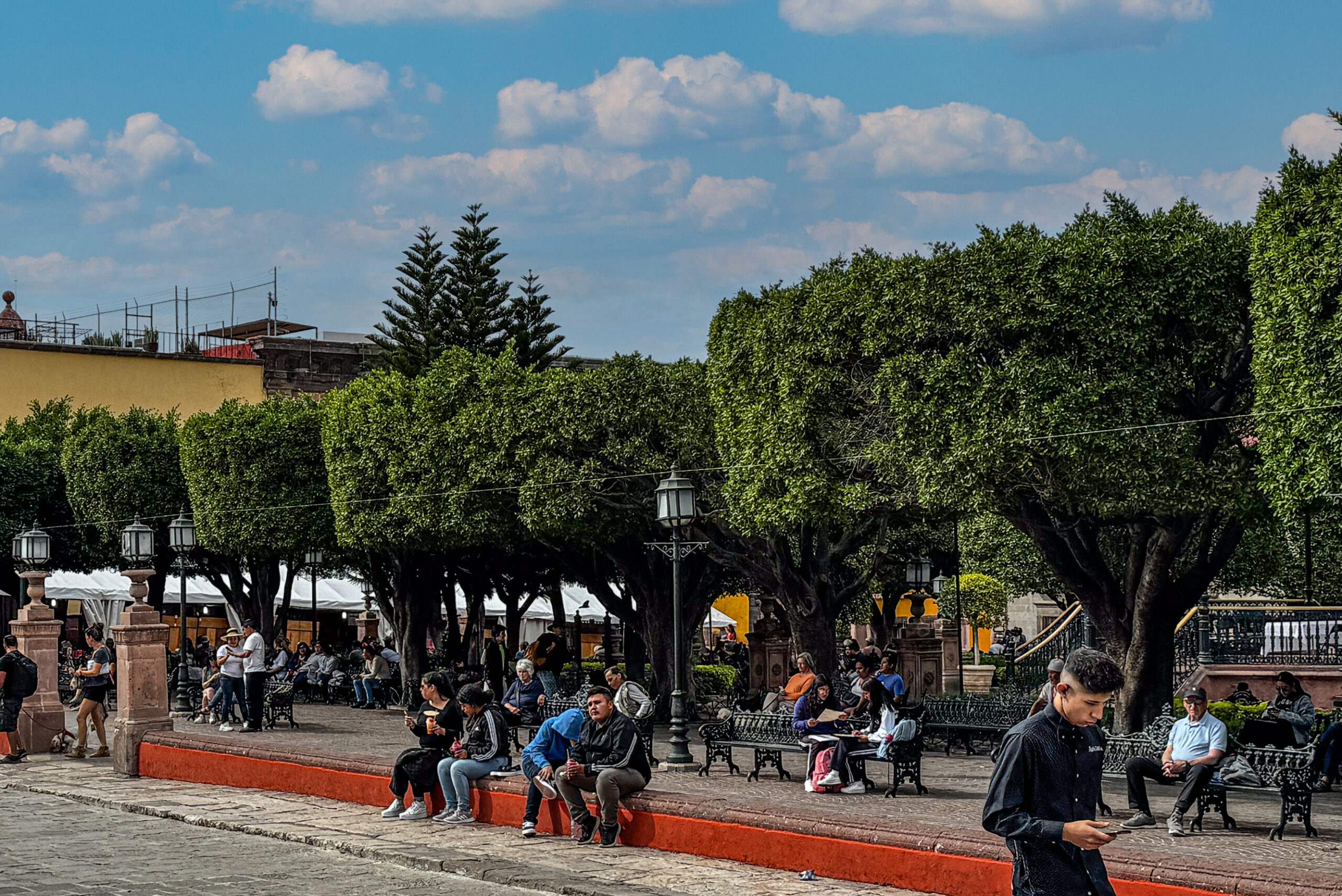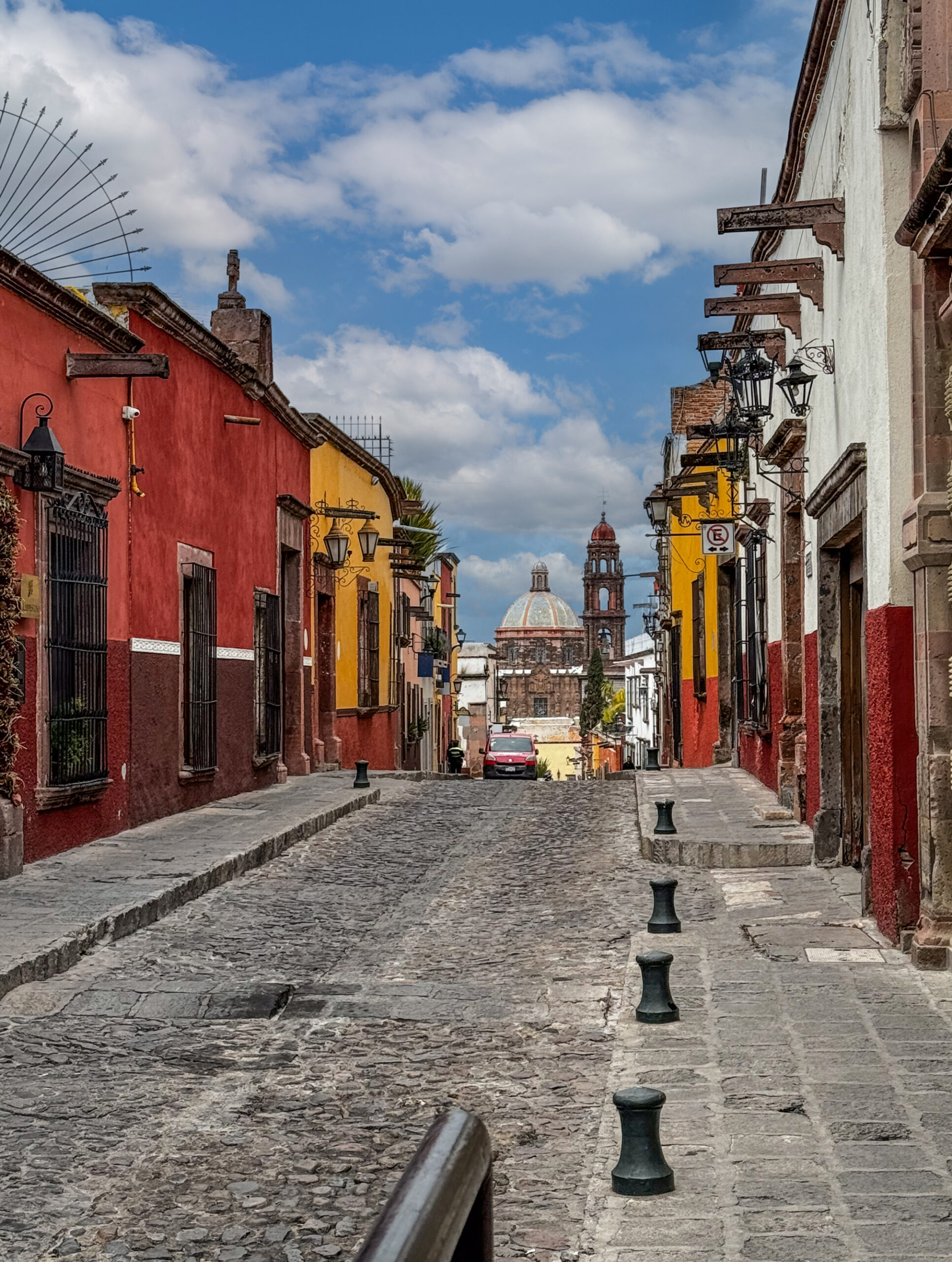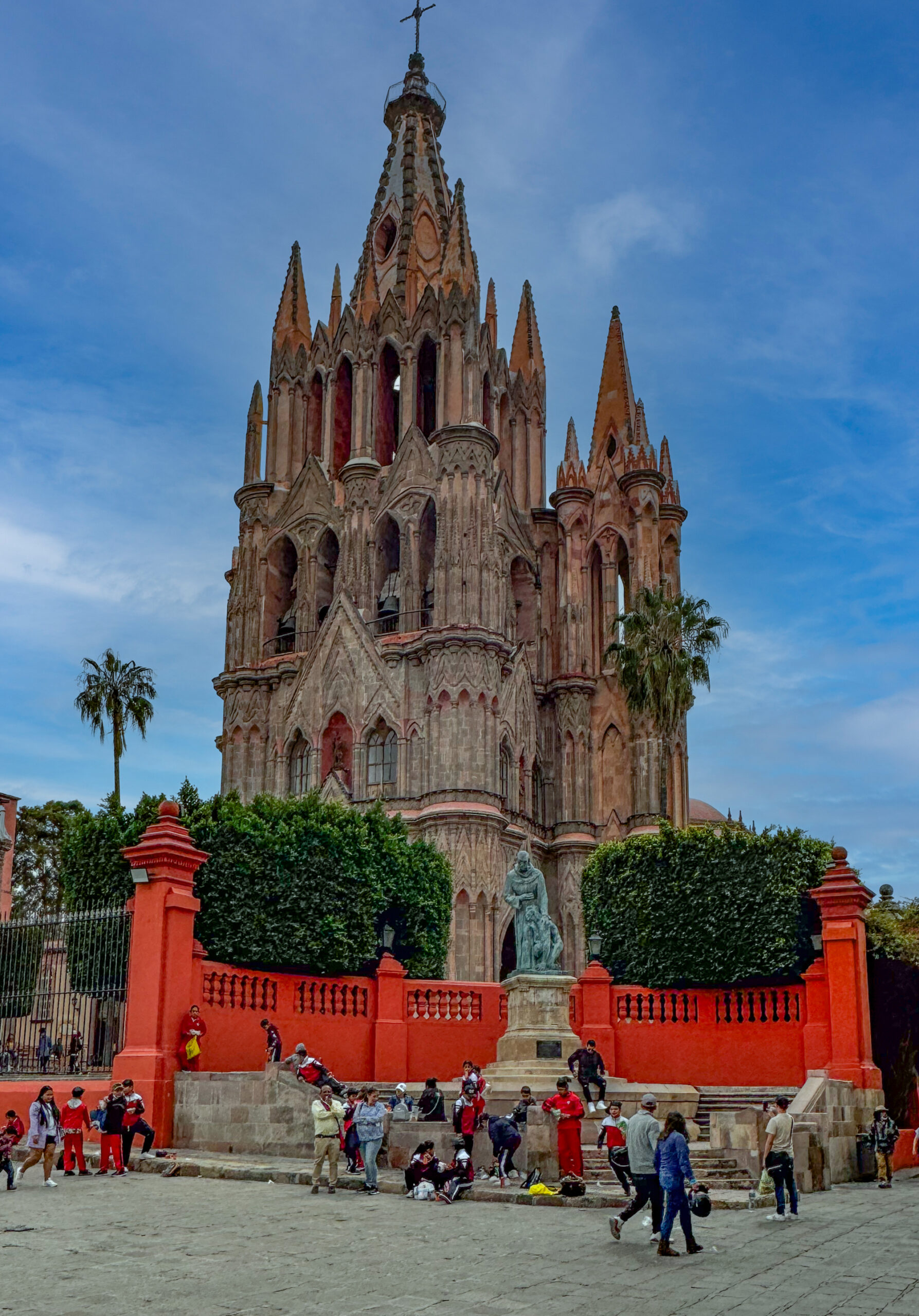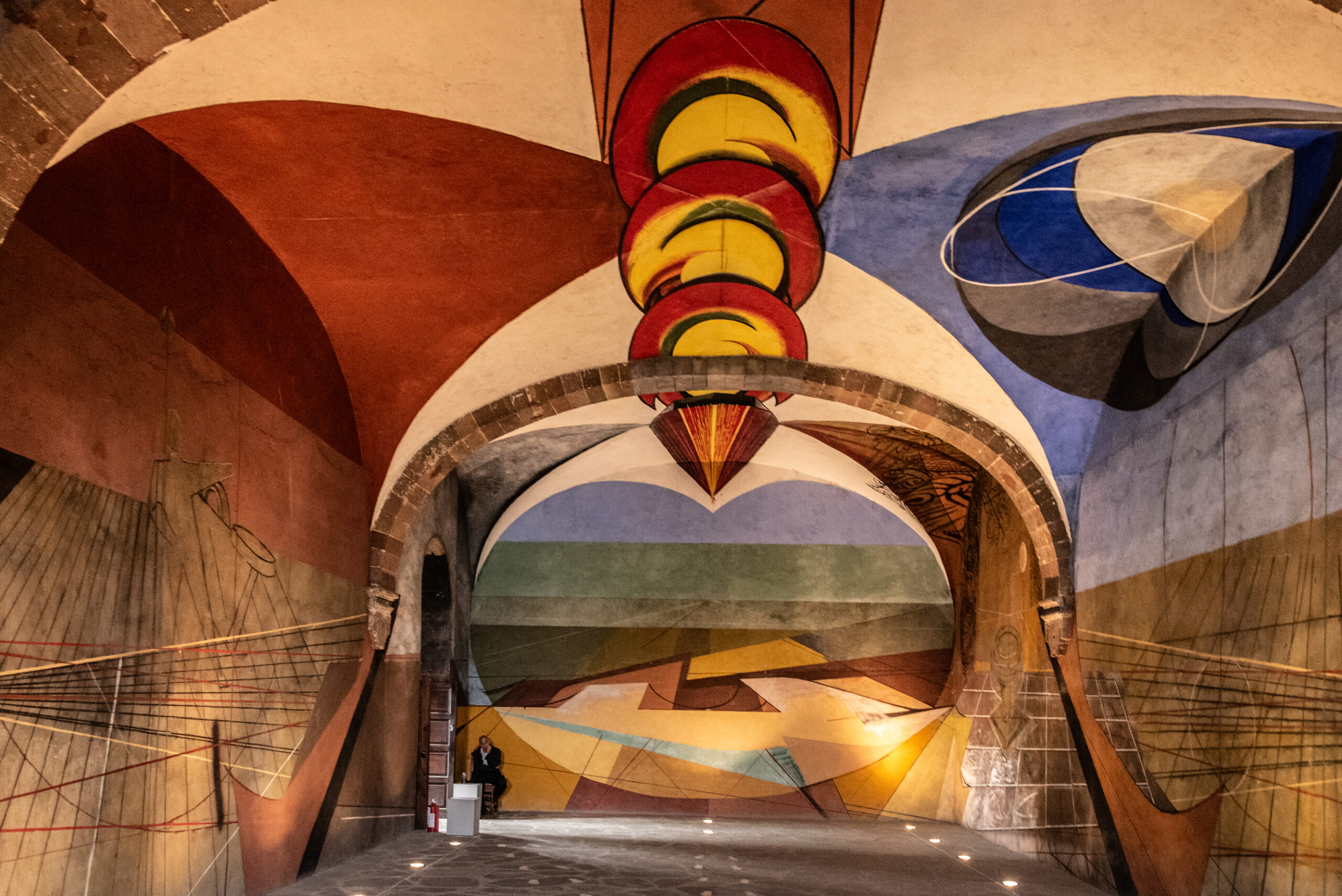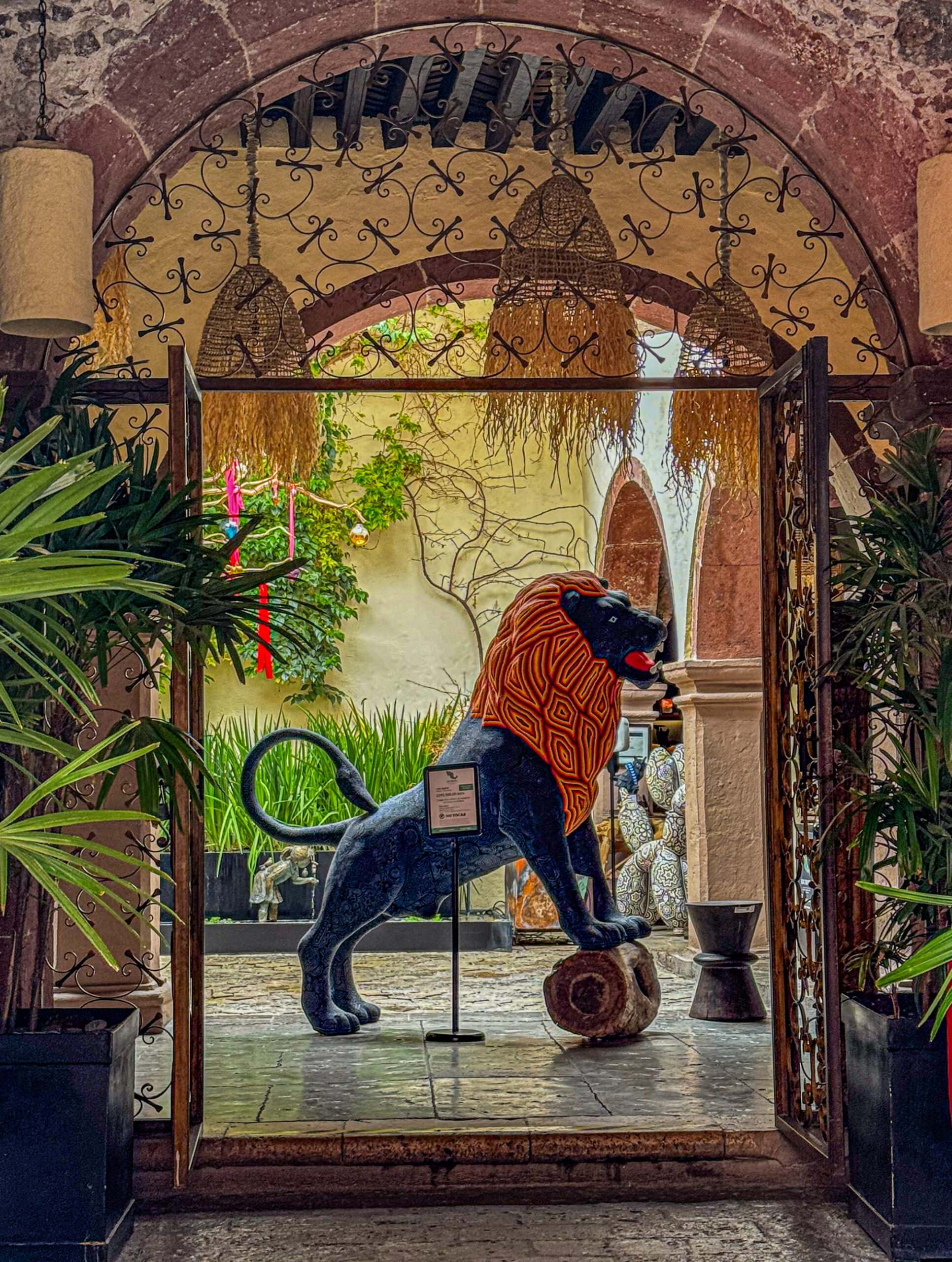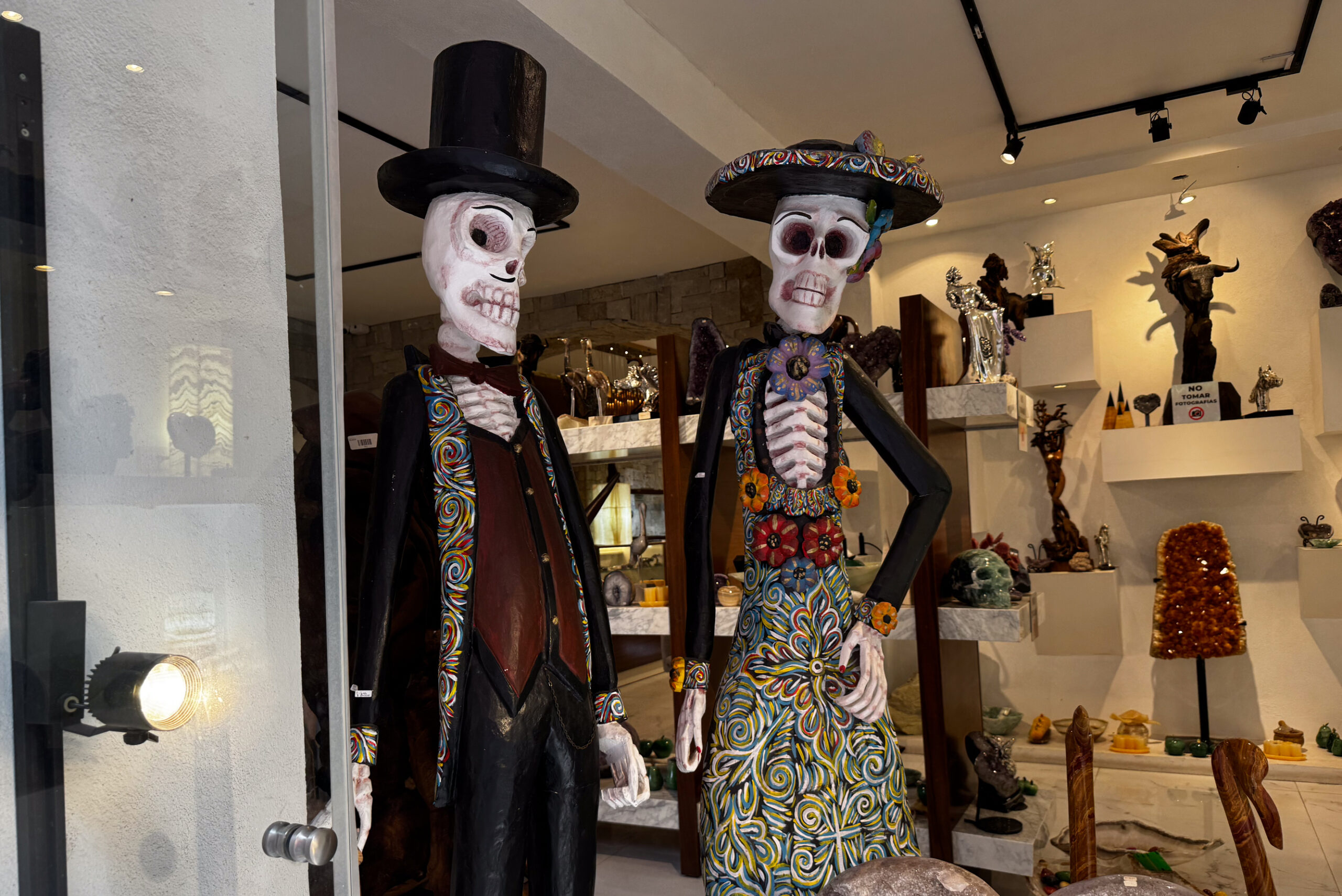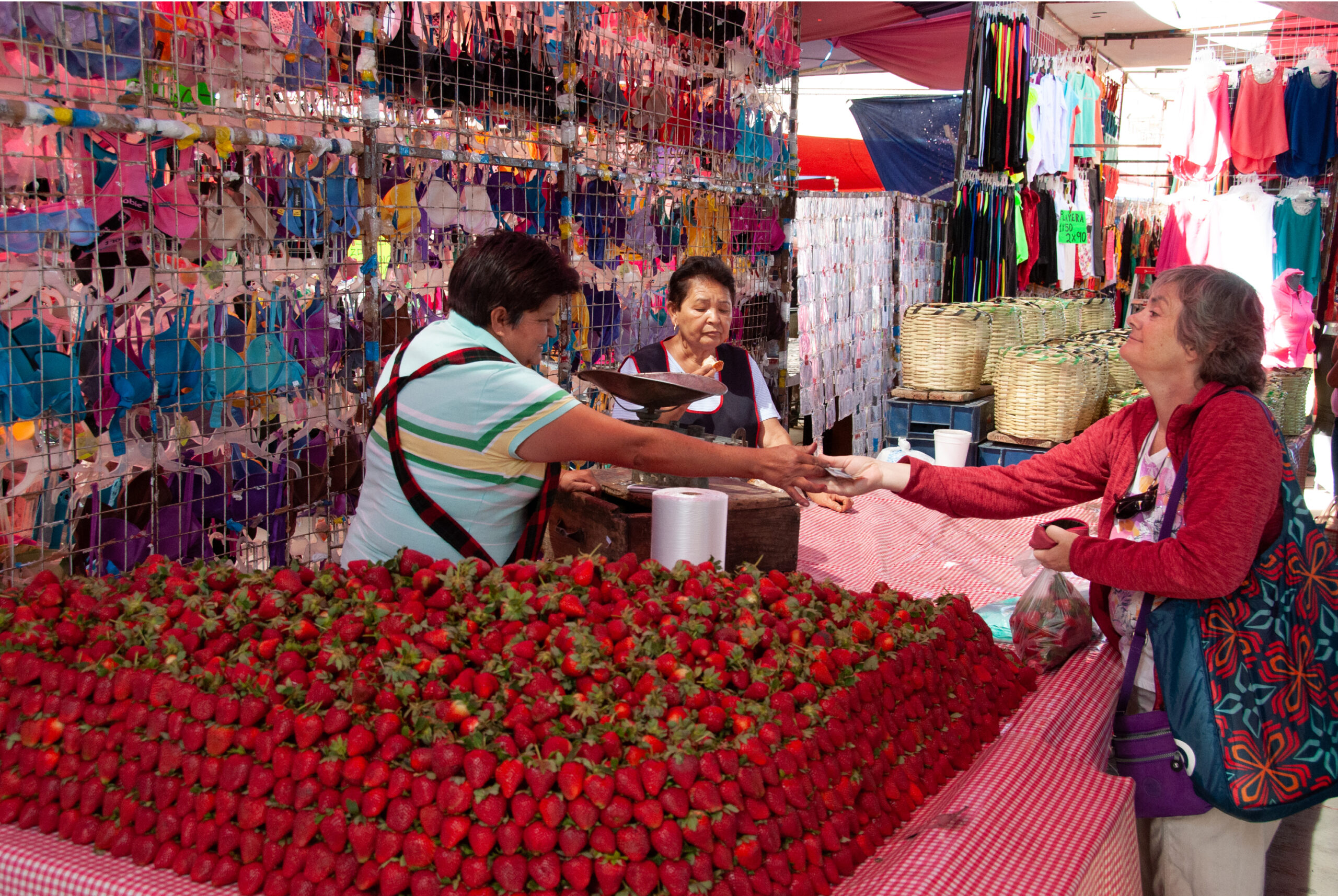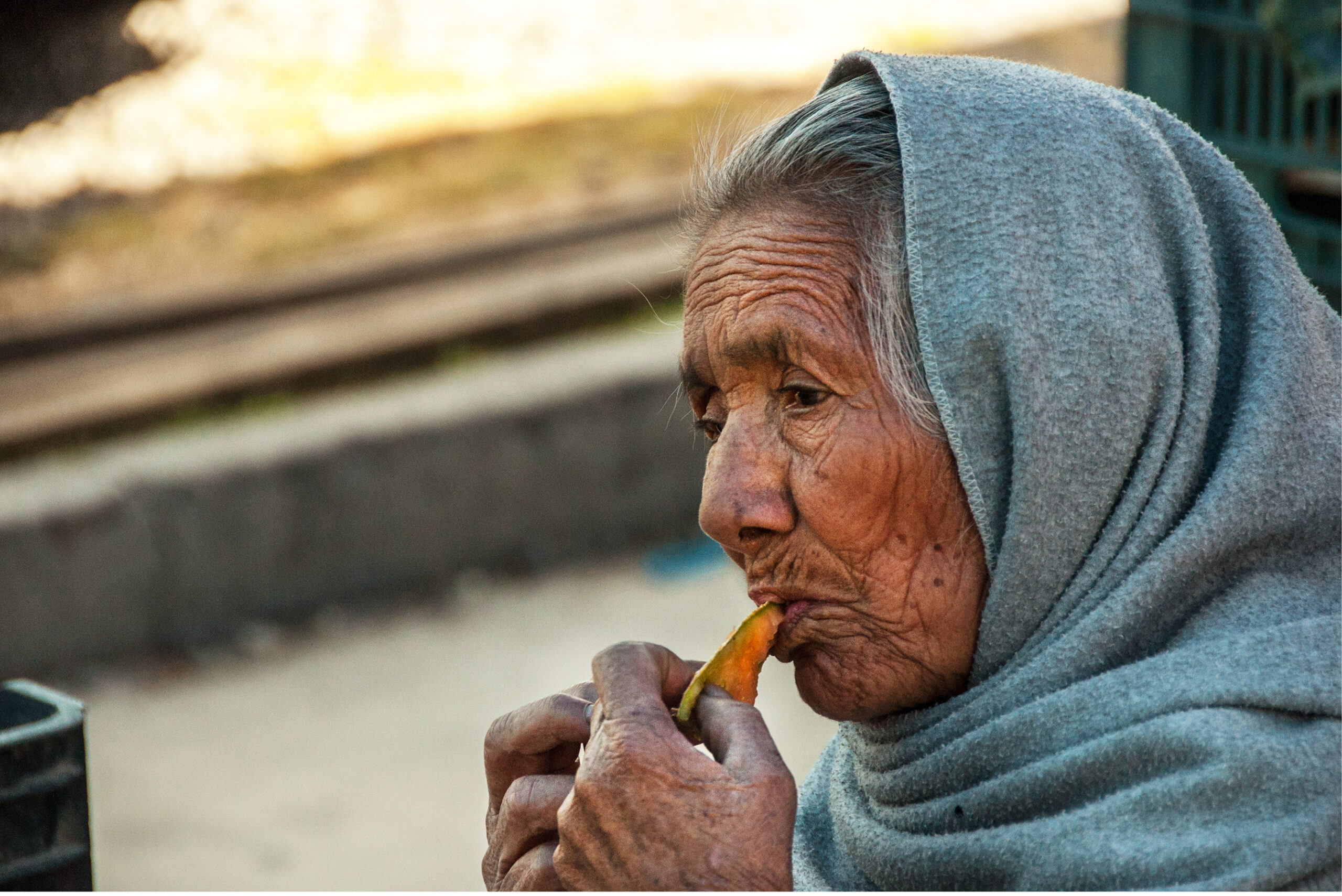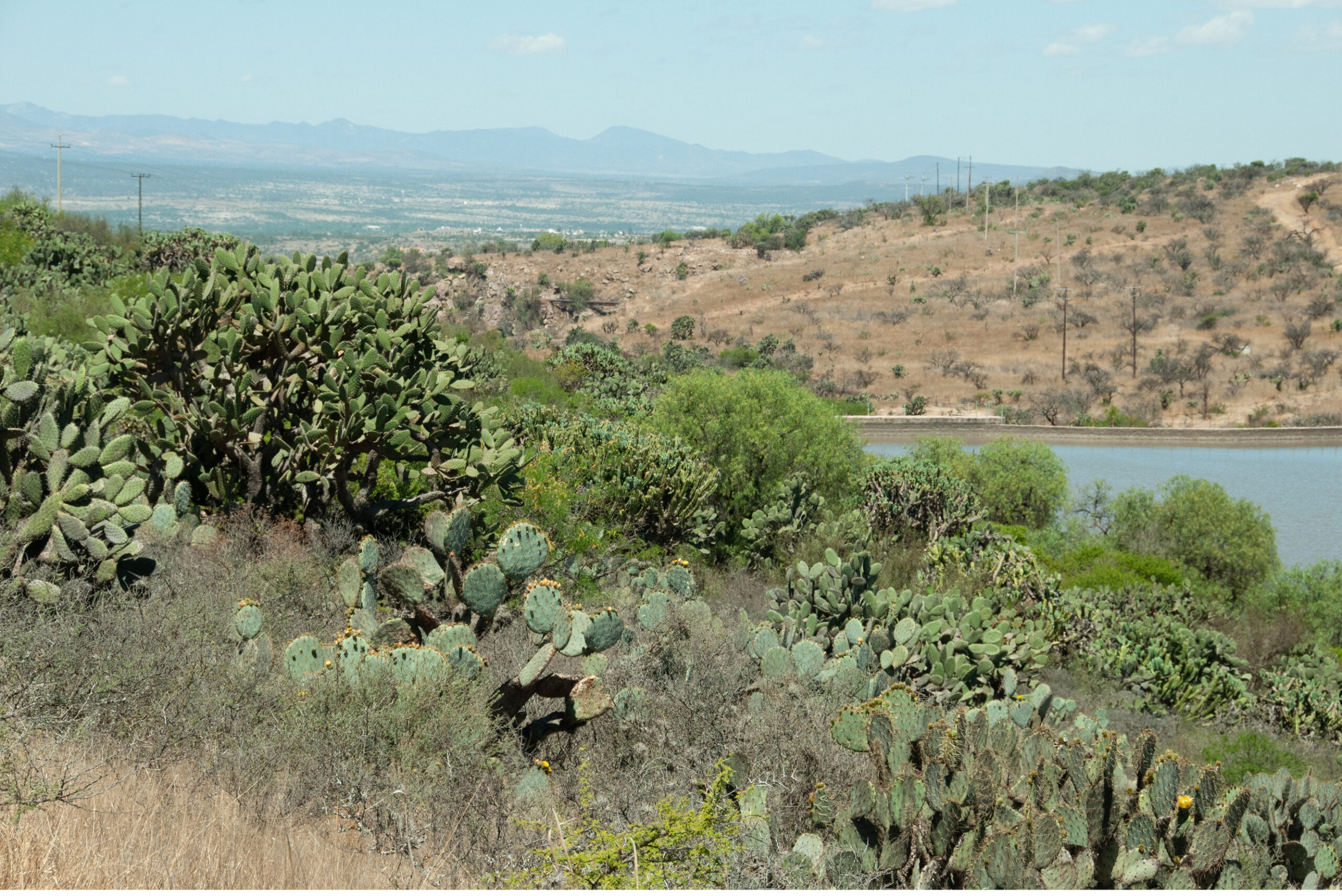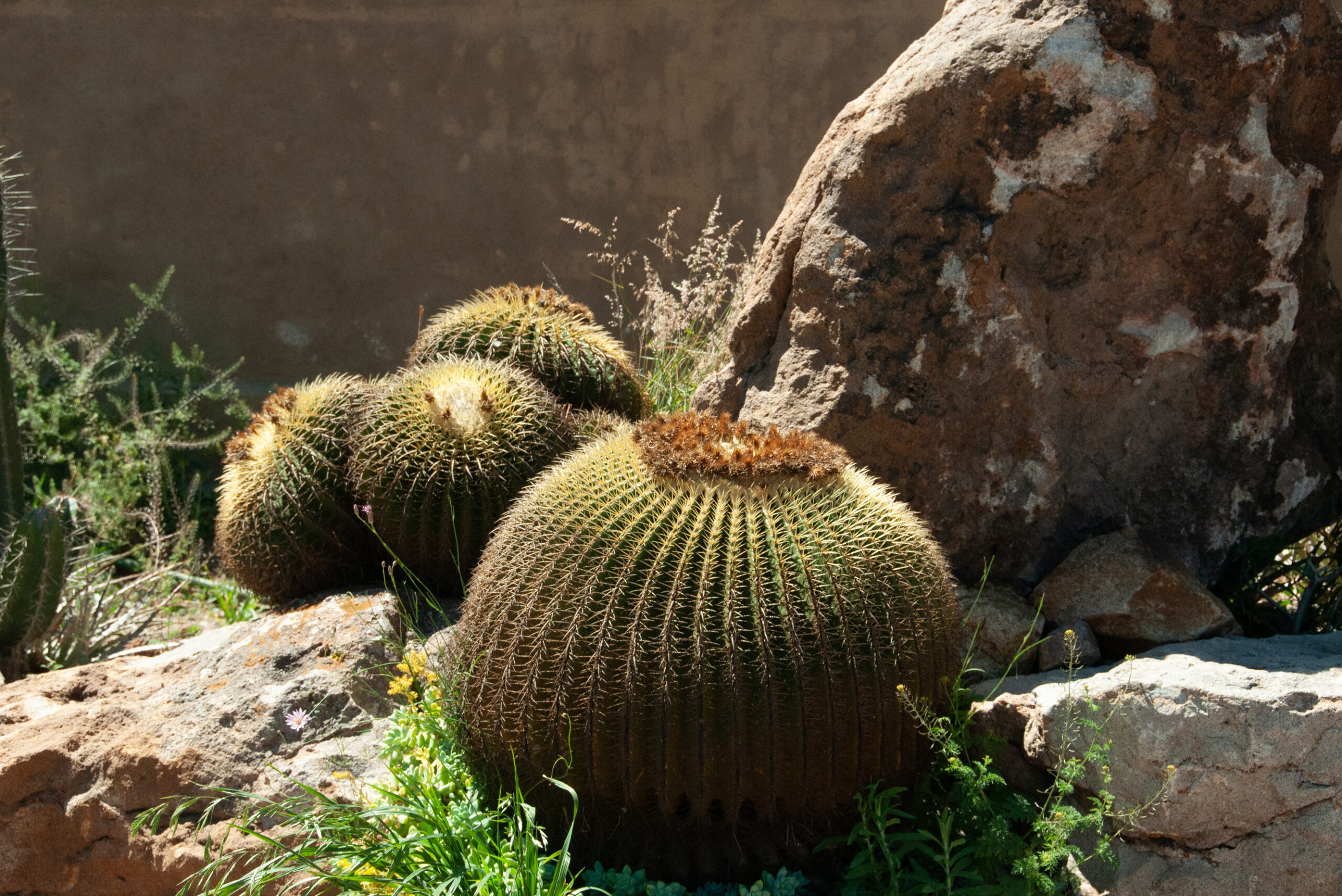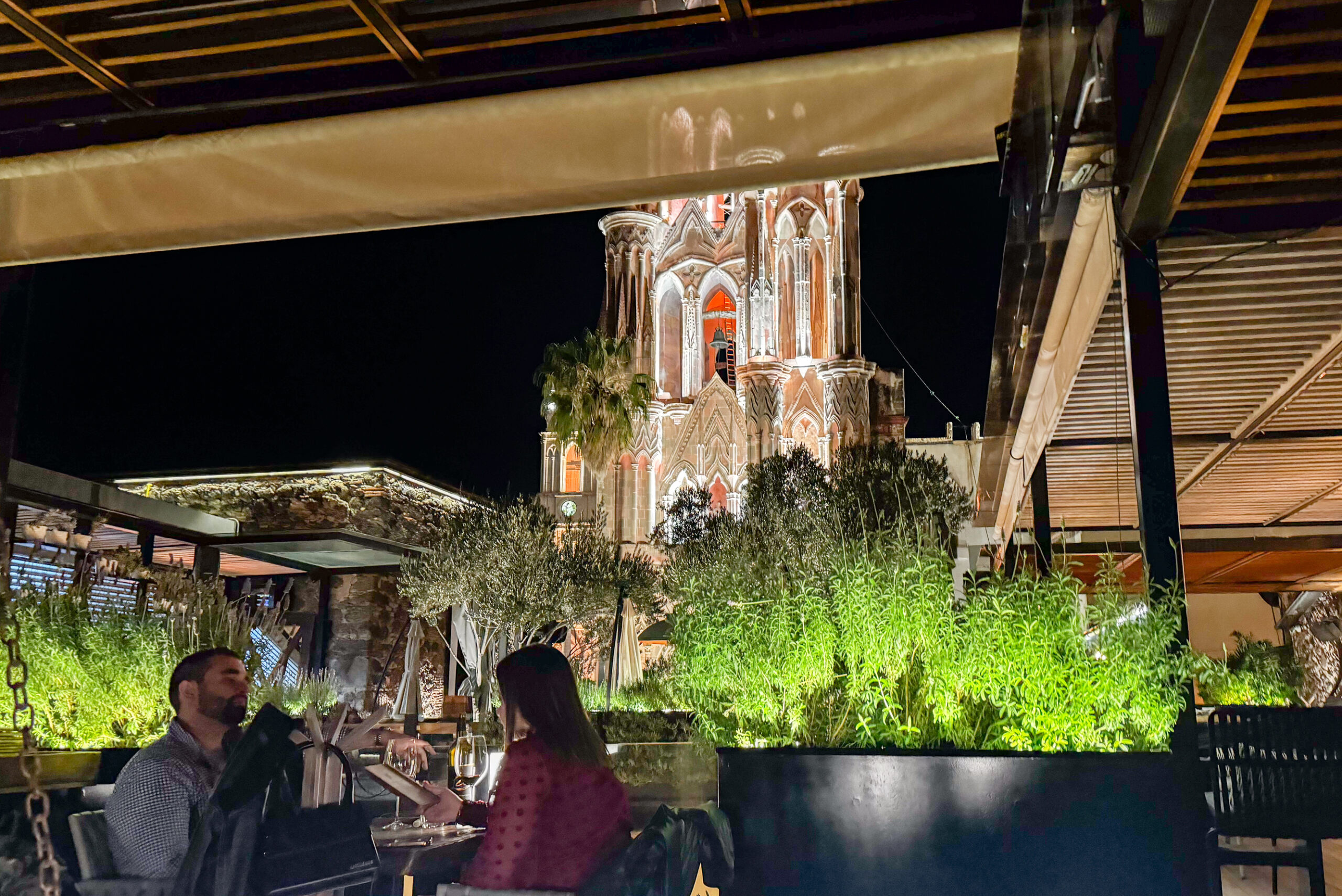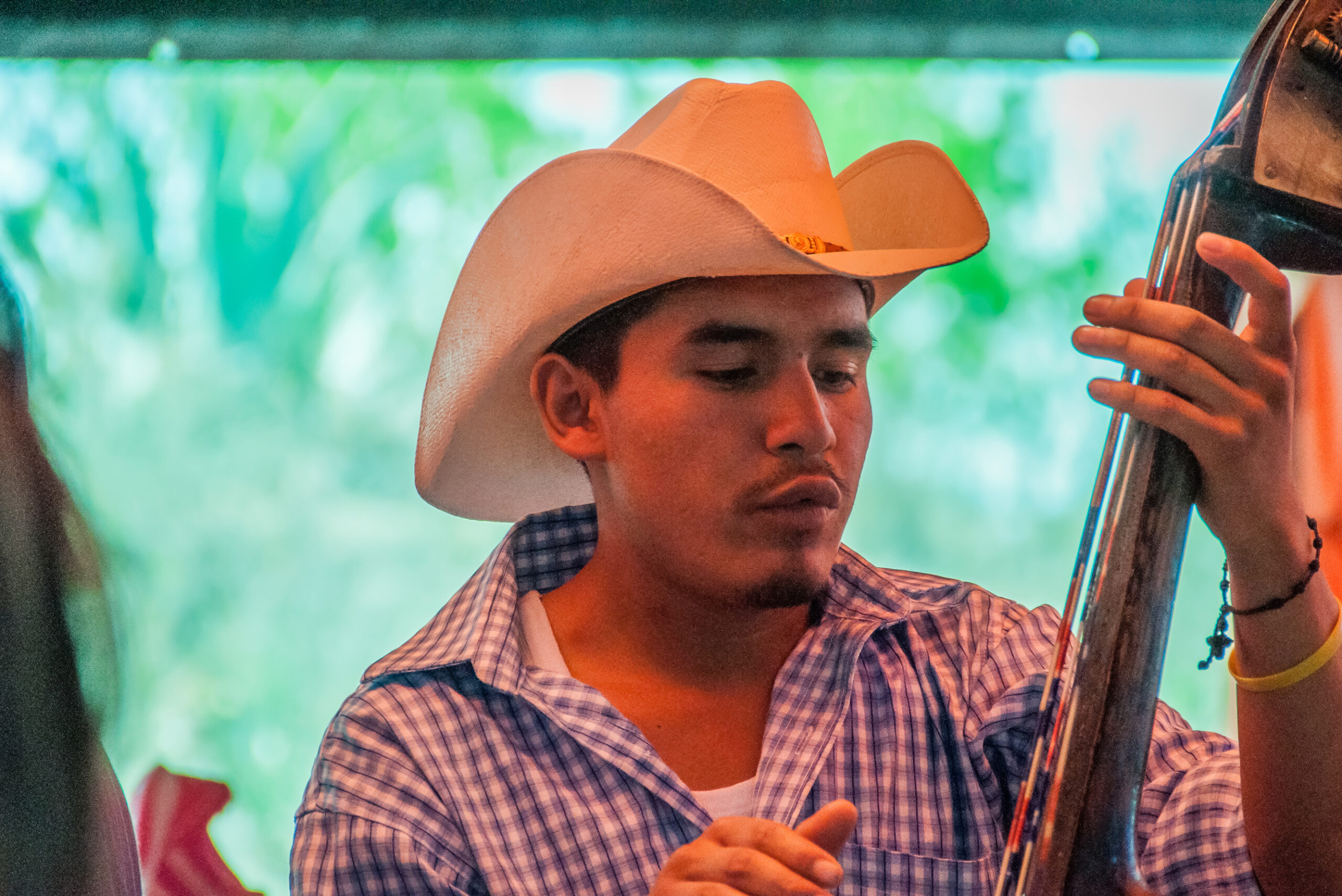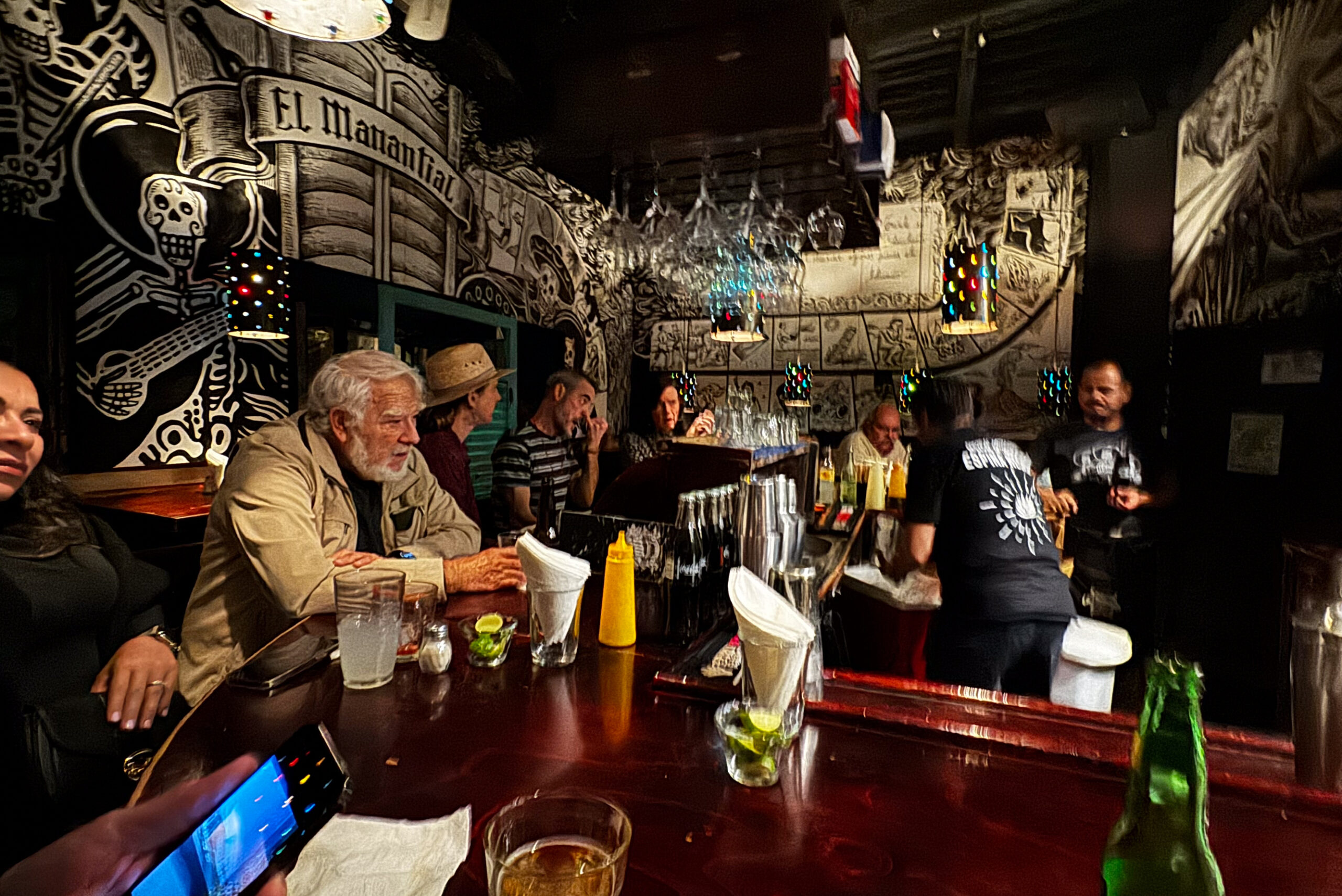Pictured above: Nineteenth century colonnaded public buildings line El Jardin’s east and west edges.
We’re in discussions right now to purchase an acrylic oil painting of a stylized contemplative, blue-robed Buddha with his gold hands resting in his lap. We discovered Strength of the Spirit by Sra. Gutiérrez. at Galeria Casa Diana on our recent trip to San Miguel de Allende, Mexico. But first, we had to measure the intended location of the artwork in our house to make sure it fit appropriately. It does!
Filled with whimsical, surreal, and playful paintings, sculptures, chairs, and small furnishings, the Galeria takes up the first floor of the elegant three-story one-time mansion of internationally renowned artist Pedro Friedeberg and his former wife and current business partner Carmen Gutiérrez. In addition to their work, Casa Diana features eighteen other local and national artists.
San Miguel is home to over 100 fascinating galleries, boasting impressive collections of traditional and contemporary art that altogether have put the city on the international artistic map.
San Miguel is Designated the 2021 World’s Best City
San Miguel is one of several sixteenth century Spanish cities established in what’s called the Colonial Crescent in the Central Mexican Plateau (Altiplano mexicano) a few hundred miles northwest of Mexico City. San Miguel carries the reputation of Travel+Leisure Magazine’s 2021 designation as the Best City in the World. That could be a burdensome responsibility for a town to measure up to, but so far, San Miguel continues to wear the mantle well.
This artistic mecca, located in Mexico’s state of Guanajuato, attracts lots of visitors from across the country and from U.S., Canada and Europe. It’s the home to a sizable ex-pat community, now 20% of San Miguel’s 72,000-person population (as of 2020). Americans make up the largest segment. Yes, you’ll see lots of retired white-haired northerners living their daily lives there.
As a potential visitor, don’t despair at this non-indigenous influx.
Simply, San Miguel oozes charm: cobblestoned streets, well-maintained earth-toned painted houses, brightly colorful doorways, interior courtyards, noble churches, food and craft markets, manicured parks, attractive restaurants and bars, and welcoming locals. It’s still a Mexican town, and the benefits from external resources brought in by new residents accrue also to local citizens and entrepreneurs, creating, admittedly, an “upmarket” community.
San Miguel’s historic downtown carries a UNESCO World Heritage designation because of its colonial authenticity, cultural integrity, and its mostly intact colonial-era physical environment.
Our February 2024’s eight-night stay in San Miguel was my second visit to the city. This time our digs were in a comfortable, renovated three-story Airbnb rowhouse, with a second-floor outdoor patio and fantastic roof deck with views of the city’s skyline on narrow, cobbled Calle (street) Ladrillera. Our street sat three blocks downhill from El Jardin, green center of San Miguel.
“Downhill” acknowledges the city’s hilly terrain, and at 6200 feet above the nearest sea, the city demands that visitors take it easy walking the streets and acclimatizing to the altitude. (You might want to take several “practice walks” regularly for a few weeks before your visit.) As for what to pack for your stay, average February daily high temperatures range in the low to mid-70s; nightime, low to mid-40s. Take layers.
I combined experiences from my two visits to San Miguel to develop this list of five suggested “must-do” activities on your several day stay in San Miguel. Join us as we…
5 Things to Do in San Miguel de Allende
Spend the First Day Walking the Town
Don your comfortable walking shoes, grab a bottle of water you purchase at the local tienda (don’t drink the local stuff; I can attest to that!), and we’ll spend the day exploring new territory. First, let’s head to El Jardin, the small park with pleached laurel trees and Victorian gazebo at the heart of this movie-set town. Along with tourists and locals (and ex-pats), we park ourselves on a wrought iron bench to people-watch and soak up the atmosphere.
Architectural gems surround El Jardin. On the east and west sides of the square, attractive nineteenth century buildings show off their arched colonnades. The star of the plaza, the neo-Gothic pink-spired Parroquia de San Miguel Arcángel, elicits gasps when visitors first encounter the landmark church. Built in the 1880s by locally-born Zeferino Gutiérrez, a self-taught architect and the town’s stonemason, he copied the styles of European churches from postcards and then drew building construction plans in the sand because his craftsmen were illiterate.
Walk in any direction down cobblestoned streets and peak into open doors of shops and galleries. Often, through open doors of former mansions, you’ll see courtyards set up as informal lunch stops or coffee shops. Our walkabouts usually end back at El Jardin, stopping at the ice cream stand at the park’s southwest corner before indulging in the another bout of people watching.
In front of us a mom and her friend try to pose her uncooperative young daughter dressed in a rose-colored gown for the waiting cameras. Ten-foot-tall papier mâché puppets in colonial dress, borne on the shoulders of people peeking out of eye holes in the skirts and trousers of the characters, float around the plaza to entertain young and not so young visitors.
A vendor with a stack of hats for sale piled on his head also sells balloons to parents for their kids. Teachers herd their red-uniformed school children on a class trip around the plaza.
Wait until we return here tonight. The square’s magnificence radiates as lights glow amidst the trees and artfully illuminate the spectacular Parroquia and adjacent La Santa Escuela de Cristo (Holy School of Christ). Groups of mariachi band players will mill about, waiting for the appropriate opportunity to serenade the audience and earn some cash.
Make it a Gallery-Hopping Day
I guarantee art-hungry visitors will be sated by the end of their San Miguel visit. We devote another day exploring the creative endeavors of a city chock-a-block with galleries. Google is our go-to source for identifying their locations and the nature of their collections.
How did this art scene come about? Two art schools laid the groundwork for San Miguel’s current reputation as an international art mecca.
The earlier University School of Fine Arts, no longer operational, was housed in a nineteenth century convent close to El Jardin. Now locally known as Bellas Artes, the beautiful building with its lush and tranquil courtyard is worth a visit to see the changing exhibitions and murals depicting Mexican life. Especially surprising––a room filled with the spectacular unfinished mural by David Alfaro Siquiero that covers four walls, ceiling, and floor.
Located several blocks southwest of El Jardin, thriving Instituto Allende offers art degrees and single classes in painting, drawing, sculpture, and other artistic disciplines, most taught in English. The imposing building contains a lovely interior courtyard and several murals, one spread over an entire wall depicting the history of Mexico. Others feature bizarre devil-like creatures alongside clerical images (not surprising), the kind that seem to pervade Mexican folklore.
Now for a unique “must-visit” art experience, we pile into a taxi (or you may want to take a nice walk from El Jardin) to La Fábrica la Aurora. A one-time major textile factory that closed in 1991 now hosts an art emporium opened in 2004. Significant remnants of the millworks––giant looms and engines––are displayed in rooms and hallways, surrounded by dozens of galleries and shops selling a wide range of contemporary and vintage artistic creations. Collections of furniture, sculptures, jewelry, paintings, international art, small decorative items and furnishings provide several hours of window shopping.
After our eyes glaze over from too much art, we relax with a tasty lunch at one of two small restaurants. Then back to El Jardin to rest, before we continue on the gallery trail.
It’s a Market Town, Too
What better place to learn about indigenous culture than to hang around the local markets. Two in-town markets connected to each other provide us with a view into regional craft-making and the popular foods and clothing locals eat and wear. In the Mercado Ignacio Ramirez, a few minutes’ walk from El Jardin, colorful fruits and vegetables, piñatas suspended overhead, and containers of sun-drenched flowers tease the senses as shoppers bargain with sellers for good prices.
In the back corner of the market, a set of steps leads to the Mercado de Artesanías (Artisans’ Market) where shops entice us to purchase silver and nickel items, wooden toys, jewelry boxes, and paper cutouts in festival colors. We escape empty-handed.
The most fascinating local shopping and cultural experience, though, opens only on Tuesdays, just outside of town, and we take a short bus ride to its entrance, arriving at 9:00 a.m. Tiangus de los Martes (Tuesday Market) provides a genuine immersion into the regional culture that doesn’t try to pay homage to the ex-pat invasion. Hundreds of stalls set up under a series of long, arched metal roofs and tarps selling almost every imaginable consumer product stimulates all our senses.
Here’s a partial list to give you an idea of the market’s enormous breadth of offerings: artfully arranged local fruits and vegetables (mounds of fresh strawberries!); meat, chicken, and fish markets (butchers cutting up animals into pieces like we’re familiar with in the supermarket); barrels of chicken feet and live songbirds.
The oleo of goods and services also includes power and hand tools; saddles and riding gear; cakes, pies, and other baked goods; kaleidoscopic displays of candies; electronics; wigs being styled; smoothie cafés; metal vases of flowers and huge potted plants; piles of pork rinds; Barbie dolls and all sorts of children’s toys; lingerie and new and used coats, shoes, hats, and shirts; blankets and shawls; local cheeses and honey; and bicycles. And the list is still incomplete.
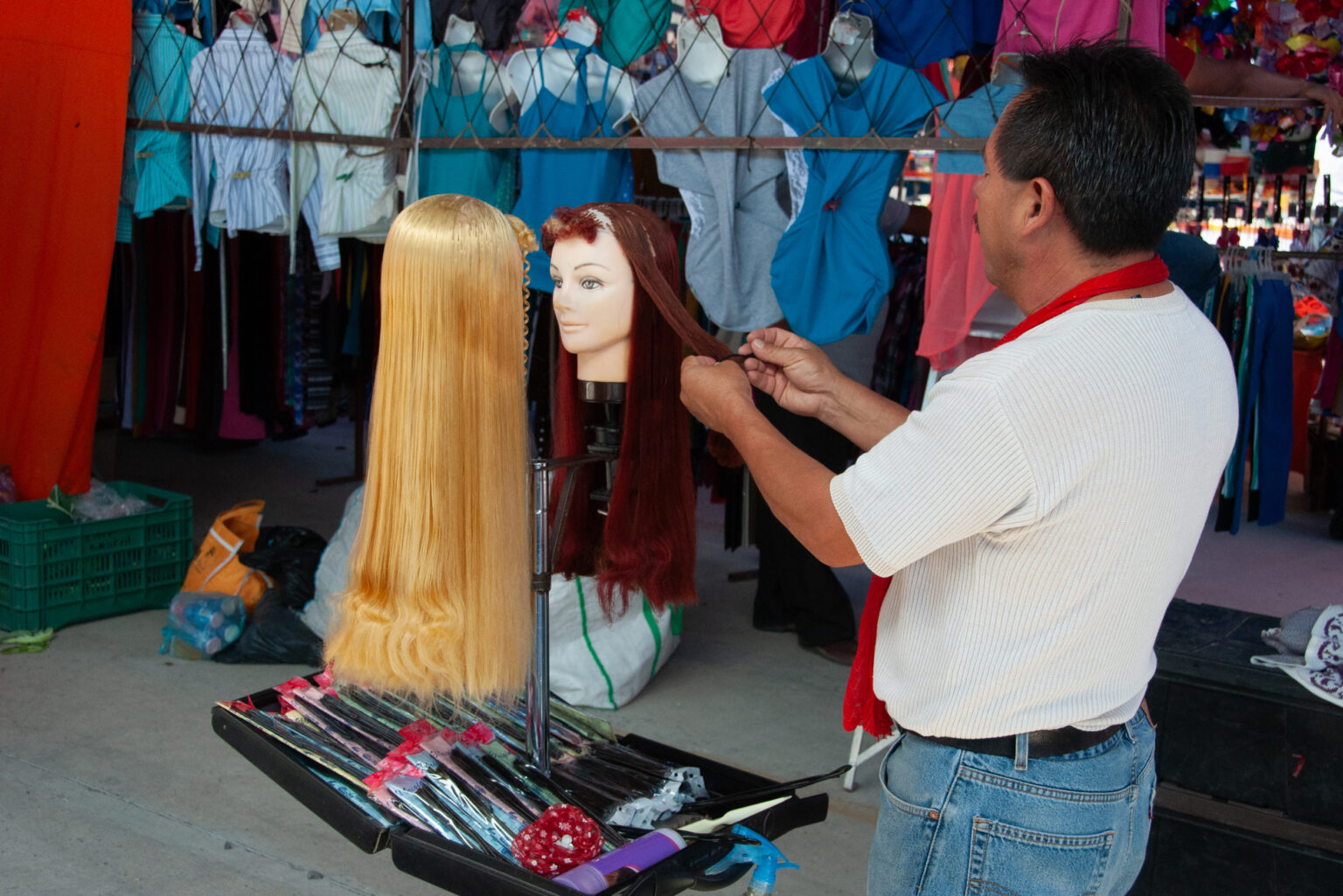
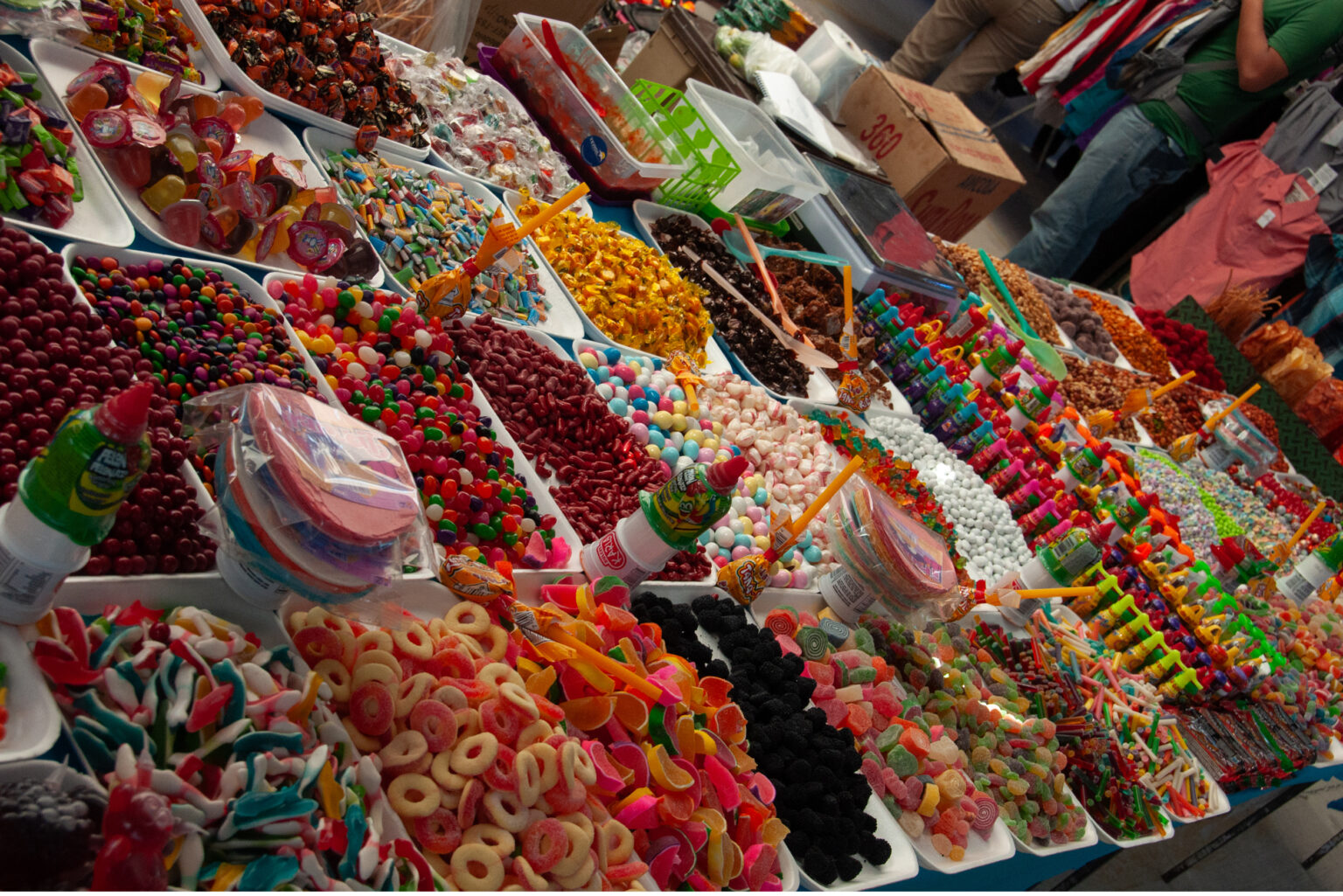
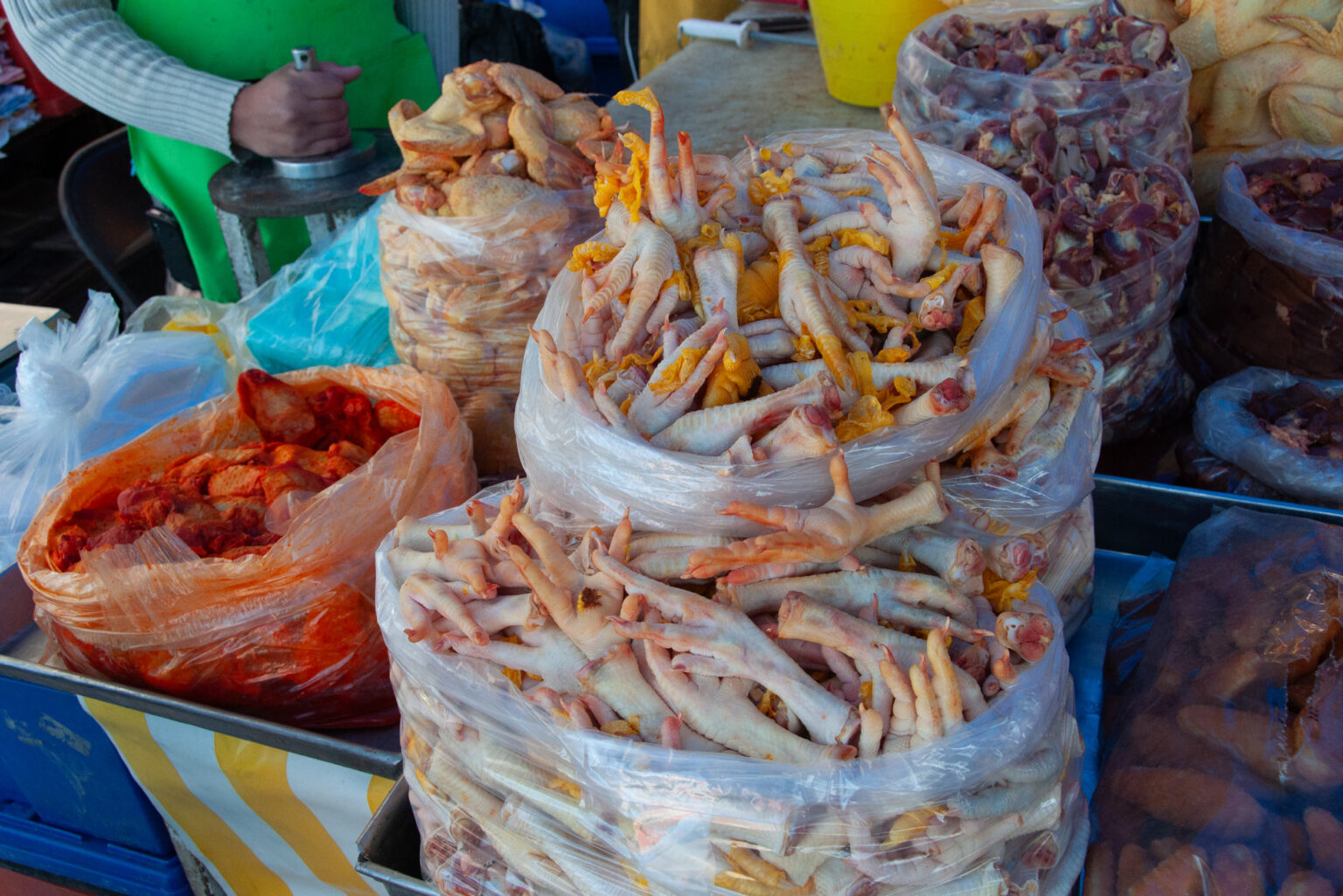
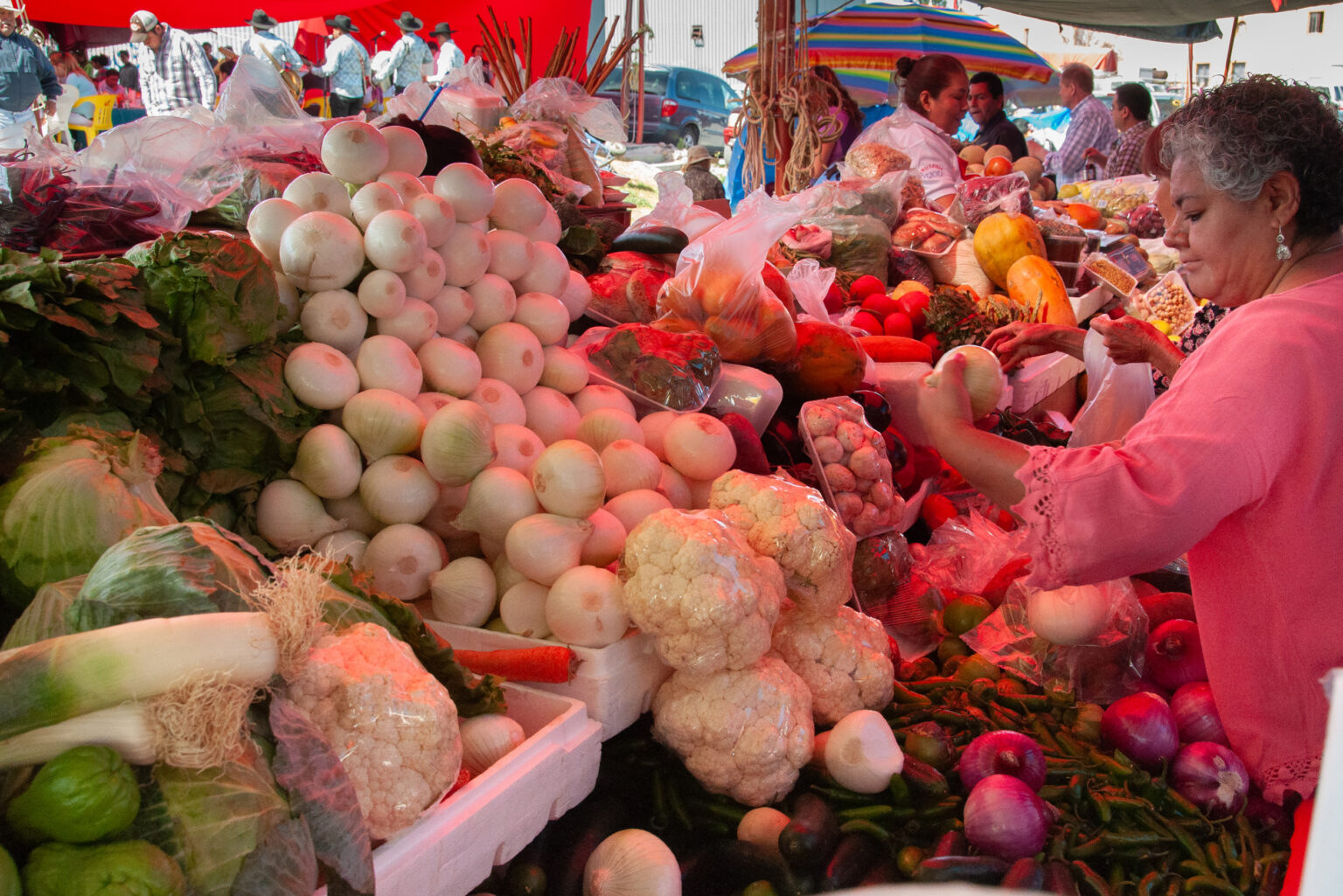
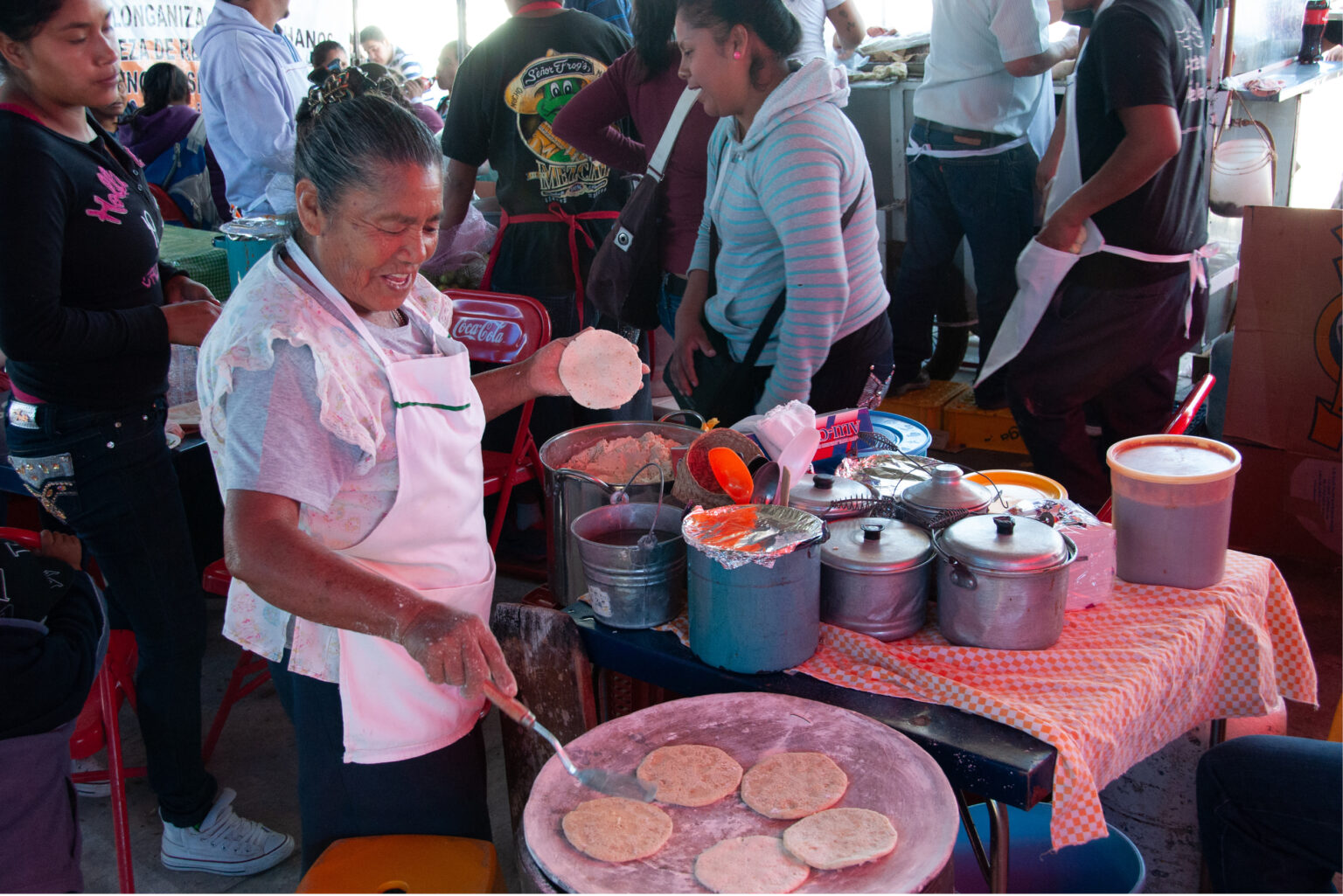
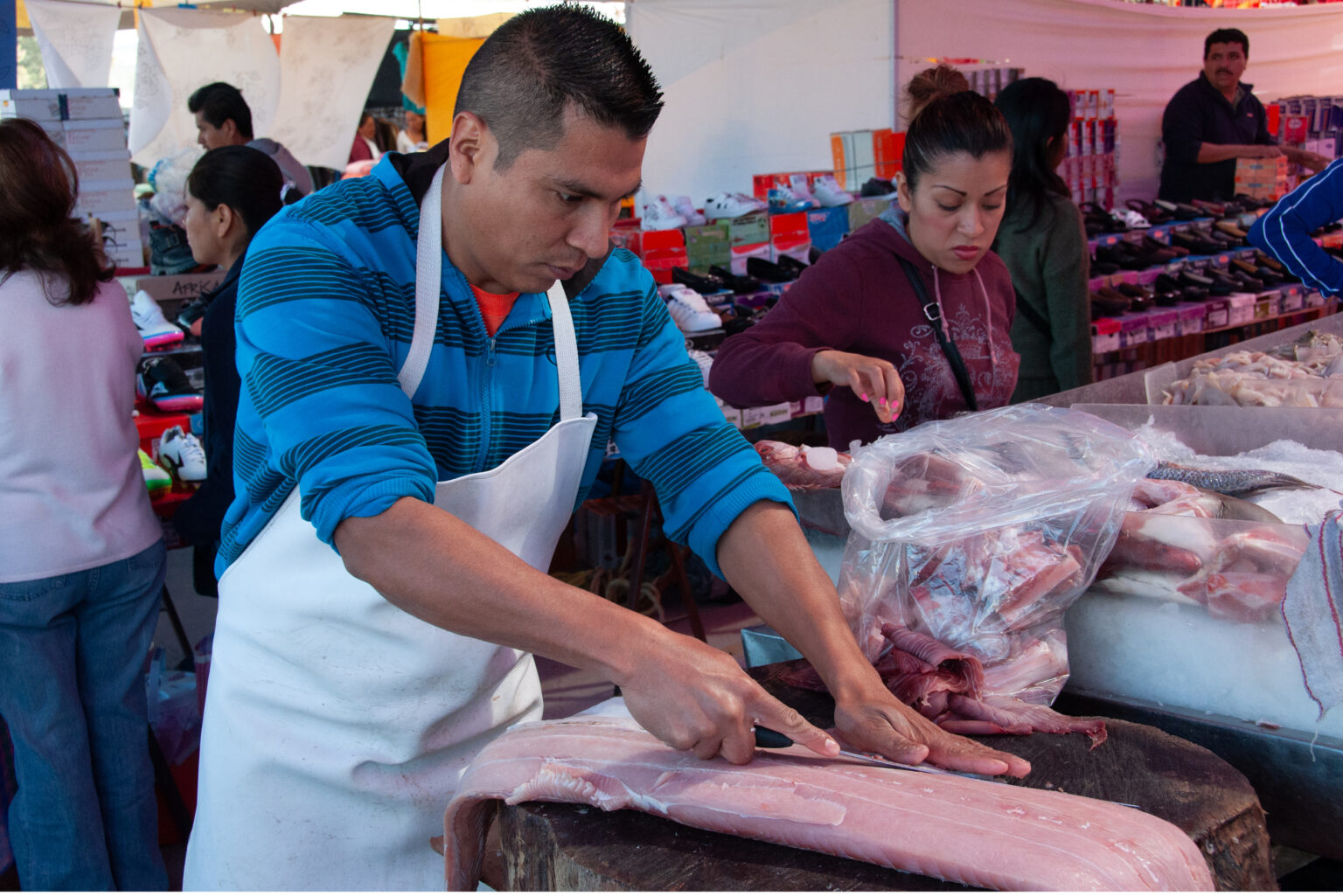


Of course, the best part of this exhilarating experience is people-watching. Shoppers peruse purveyors’ goods, negotiating quantities and prices. Grandparents and parents tow toddlers through the aisles. Delivery men push carts through the crowds. We rest on a bench to listen to five musicians wearing cowboy hats play lively local tunes.
Overstimulated, I need to fill my growling stomach. Many food stalls entice shoppers and visitors to stop for lunch and enjoy freshly prepared local dishes. Chicken in mole sauce with beans and rice satisfies my hunger. Then it’s time for siesta, and we return to Calle Ladrillera to stretch out on the roof deck sofa.
Take a Hike in San Miguel’s Incredible Botanic Garden
About a mile northeast of town center, El Charco del Ingenio’s 170-acre preserve hosts an extensive collection of Mexico’s cacti and other succulents, including rare species, from this semi-arid region. The reward for our 30-minute vigorous walk uphill to the entrance is this stunning experience amidst nature, art and factory ruins. (A short taxi ride will get you there without the climb.)
Sited on a once thriving industrial zone from the early twentieth century whose dam provided water to the La Aurora textile mill (now the gallery complex mentioned above), committed environmentalists purchased the land and created the botanic garden and natural preserve in 1991. El Charco now carries a federal designation as a natural protected area. The 14th Dalai Lama blessed the park as a “Peace Zone” in 2004.
In addition to its spectacular setting for highlands scrub, canyon, wetlands, and industrial ruins, El Charco serves as a stage for artistic and cultural expression. The Plaza de los Cuatro Vientos (Plaza of the Four Winds) represents the spirits of Indigenous people and their beliefs in the origin of the universe.
We wander panoramic trails through various ecosystems, encountering sculptures and artistic installations that incorporate plants. Teachers leading their chattering and excited students on a class trip over meandering pathways pass us and wave.
Glad that we’re wearing hats and sunscreen, the brilliant day highlights the park’s awe-inspiring wilderness setting.
Dine at a Rooftop Restaurant
San Miguel can boast about its extensive dining scene. From local, inexpensive eateries and carry-out options to linen table cloth-and-napkins establishments, foodies will not feel deprived in San Miguel. Equally, the range of culinary choices—local authentic Mexican fare (don’t expect all Tex-Mex) to Spanish, Italian, Japanese and continental cuisines and steak houses can be found at different price levels.
Our Airbnb kitchen sees action at breakfast and then only on one evening when we cook at home; the rest of the time we sample the town’s many gustatory offerings. Our hostess provides a list of her favorite watering holes and dinner destinations, and Trip Advisor gives us some unusual places to try over our week’s stay.
Make sure you celebrate Happy Hour with cocktails and then dine at a few rooftop restaurants on a beautiful night. The two we patronize each had impressive views of the city that only add to the atmospheric romance of San Miguel.
We kick off our San Miguel week at Atrio, an upscale establishment off El Jardin Plaza that has a spectacular view of the Parroquia’s lighted magical pink spires and the surrounding rooftops. From its inventive menu, I savor Pork and Pear, a suckling pig delight, followed by a semifreddo marzipan (an ice cream-like confection). A yummy chocolate martini tops off the evening.
Our second rooftop experience––the moderately-priced Francesco’s Italian Restaurant––overlooks the nightlife on busy Calle Zacateros’ restaurant row. Pasta, pizza, handsome young waiters, a hip DJ, and an impromptu and impressive fireworks display over neighboring rooftops complete an enjoyable evening.
Other ground level restaurants we enjoy during the week include Pueblo Viejo (near El Jardin) and Garambullo (near Mercado Ignacio Ramirez) for lunch. We enjoyed two other dinner spots––Bovine and Spice Market. Our “find,” El Manantial, at Calle Barranca 78, greets us with walls full of white skeletons on black wearing sombreros. A cozy bar (where we always prefer to dine in almost any eatery), friendly bartender and waitstaff, and a creative tapas menu with ceviche, and shrimp, scallop and octopus dishes provides the perfect ending to our San Miguel week.
Okay, I’m sneaking in a sixth recommendation...
If you’re in San Miguel for a week, consider taking a day trip out of town by bus, group tour or private car to visit another nearby city, where you’ll find Mexican culture a bit more undiluted.
From San Miguel, I’ve visited Querétaro, impressive capital of the adjoining state, and quaint Dolores Hildago. Mexico’s tourism office named this town Publico Mágico (Magic Town) several years ago. In front of the Dolores parish church, Father Miguel Hildago kicked off the movement for Mexico’s independence from Spain in a fiery 1810 speech.
My top recommendation is a day trip to beautiful state capital Guanajuato. Rich from its productive silver mines over the centuries, Guanajuato itself is crammed in a bowl-like ravine surrounded by hills, its UNESCO World Heritage historic center filled with impressive public buildings, mansions, churches, and houses painted in striking colors. Streets and narrow lanes twist around the hill’s topography. Green plazas break up the tight neighborhood grid.
Poke into open public buildings and churches to catch a glimpse of their artful interiors. I enjoyed discovering Mercado Hildago, the indoor, two-level craft and food market established in 1910 in a then-recently completed impressive train station that never saw its first locomotive when the project went belly-up. If you do go, also pay a visit to fascinating El Museo de las Mumias (Mummy Museum), in addition to the city’s attractive and charming historic center.
Traveling to San Miguel: Pack Your Bags for a Cultural Mexican Adventure
San Miguel draws you into its casual lifestyle, and your time there will fly by, as ours did, once you start your explorations. I’m sure you’ll return from this cultural indulgence with a desire to discover more of Spanish colonial Mexico.
If You Go
BY PLANE:
Two airports service San Miguel:
- Guanajuato International Airport (BJX) in León:
- Located almost 60 miles from San Miguel
- Direct international flights from: Houston, Dallas, Atlanta, Chicago, Oakland, Los Angeles, San Antonio, San Jose
-
Transportation to San Miguel (prices as of March 2024):
- Hired car– 1 hr, 34 mins. About $150 (We used sanmigueldriver.com, Cesár Nistal–owner. He’s also a tour guide)
- Taxi–1 hr, 51 mins. $110-$140
- Bus–2 hrs, 30 mins. $11-$35
- Shuttle–1 hr, 51 mins. $27 (BajioGo Shuttle is one of several companies—check on website)
- Querétaro International Airport (QRO):
- Located about 47 miles from San Miguel
- Direct international flights from: Houston, Chicago, Dallas, Detroit, San Antonio.
- Transportation to San Miguel (prices as of March 2024):
- Hired car–1 hr, 10 mins. About $80-$90
- Shuttle–1 hr, 10 mins. $30
- Bus–3 hrs, 32 mins. $6-$35
SAN MIGUEL TRANSPORT:
- Taxi–$4-$5 to go anywhere in the city
AREA ATTRACTIONS:
- El Charco del Ingenio (nature preserve) $5
- Day Trip to Guanajuanto, Minibus small group tour $90.50

